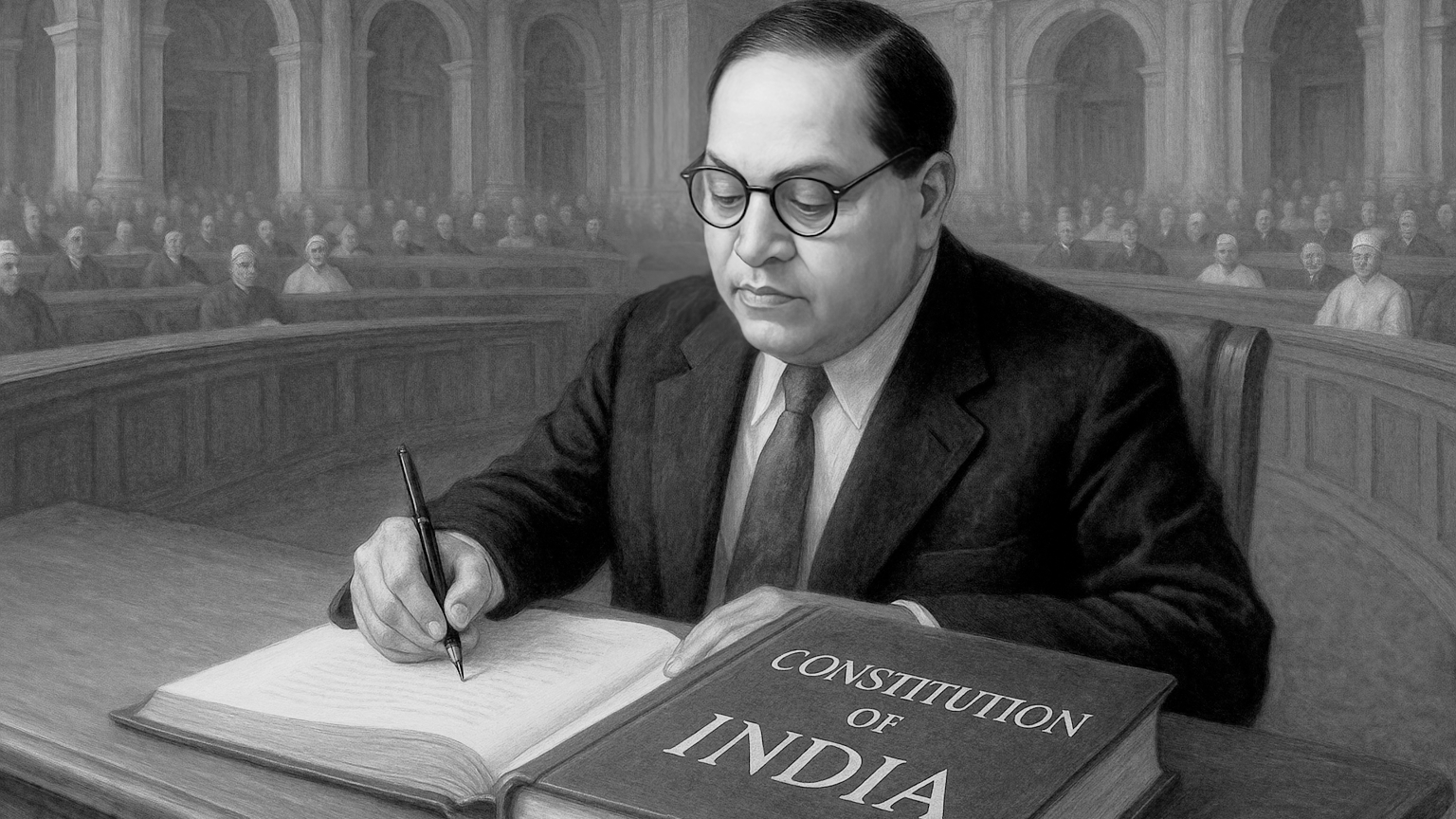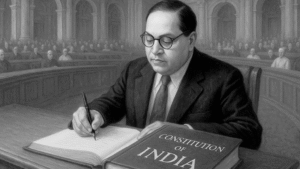The Preamble of the Indian Constitution: History, Meaning & Amendments
🧭 Introduction
The Preamble to the Constitution of India is a beautifully crafted declaration of the nation’s ideals. It reflects the spirit of the Constitution, the vision of its framers, and the moral commitment to uphold justice, liberty, equality, and fraternity in a sovereign and democratic nation. It is not just symbolic—it is enforceable in principle and foundational to India’s constitutional identity.
📜 Full Text of the Preamble
WE, THE PEOPLE OF INDIA, having solemnly resolved to constitute India into a
SOVEREIGN SOCIALIST SECULAR DEMOCRATIC REPUBLIC
and to secure to all its citizens:JUSTICE, social, economic and political;
LIBERTY of thought, expression, belief, faith and worship;
EQUALITY of status and of opportunity;
and to promote among them all
FRATERNITY assuring the dignity of the individual and the unity and integrity of the Nation;IN OUR CONSTITUENT ASSEMBLY this twenty-sixth day of November, 1949, do
HEREBY ADOPT, ENACT AND GIVE TO OURSELVES THIS CONSTITUTION.
🕰️ Historical Background
- 📆 Drafted by: Dr. B.R. Ambedkar and the Drafting Committee.
- 📜 Inspired by: U.S. Constitution, French Revolution (Liberty, Equality, Fraternity).
- 📅 Adopted: 26 November 1949
- 🚩 Enforced: 26 January 1950 (Republic Day)
India’s Preamble represents the essence of its entire Constitution, expressing both its legal authority and its moral compass.
🧩 Word-by-Word Meaning of the Preamble
| Term | Meaning |
|---|---|
| We, the People of India | Establishes the sovereign will of citizens as the ultimate authority. |
| Sovereign | India is free to make internal and foreign policy decisions independently. |
| Socialist | Emphasizes equity and welfare, added in 1976 to reflect inclusive policies. |
| Secular | State treats all religions equally with no official religion. Added in 1976. |
| Democratic | Citizens have equal voting rights; power is exercised through elected representatives. |
| Republic | No monarchy; the President is the elected head of the state. |
| Justice | Covers social, economic, and political aspects for fair treatment. |
| Liberty | Guarantees freedom of thought, expression, faith, and worship. |
| Equality | Equal status and opportunity for all citizens regardless of background. |
| Fraternity | Promotes brotherhood and unity among Indians. |
| Integrity | Ensures territorial and national unity; added in 1976 to counter internal threats. |
🛠️ Amendment to the Preamble: 42nd Amendment Act, 1976
This was the only amendment ever made to the Preamble.
| Aspect | Before 1976 | After 1976 | Reason for Amendment |
|---|---|---|---|
| National Nature | SOVEREIGN DEMOCRATIC REPUBLIC | SOVEREIGN SOCIALIST SECULAR DEMOCRATIC REPUBLIC | To include socialist and secular values explicitly during Emergency (1975–77). |
| National Integrity | “Unity of the Nation” | “Unity and Integrity of the Nation” | To stress territorial integrity amid separatist tensions. |
🧑⚖️ Introduced by: Prime Minister Indira Gandhi
📜 Legal basis: 42nd Constitutional Amendment Act, 1976
⚖️ Upheld by Supreme Court in Kesavananda Bharati Case (1973) as part of the Basic Structure doctrine.
📚 Important Case Laws
- Kesavananda Bharati v. State of Kerala (1973):
Held that the Preamble is part of the Constitution and reflects the “Basic Structure Doctrine”—can’t be destroyed by amendment. - Berubari Union Case (1960):
Earlier said Preamble is not enforceable. This was overruled later.
🎯 Importance of the Preamble
- Serves as the soul of the Constitution
- Acts as a guide to interpret constitutional provisions
- Declares the ideals and goals of the Indian state
- Promotes unity, justice, and dignity for all
The Preamble reflects India’s moral commitment to democracy and its responsibility toward its people.
Was the 42nd Amendment to the Preamble of the Indian Constitution truly necessary—or was it more political, influenced by the Emergency or done to appease certain sections? Let’s examine the intention, timing, political background, and long-term impact in detail:
🧠 Background of the 42nd Amendment (1976)
Context: The amendment was passed during the Emergency period (1975–77), declared by Prime Minister Indira Gandhi citing “internal disturbances.”
Parliament at the time: Largely controlled by the Congress party, with limited opposition due to arrests, censorship, and suspension of civil liberties.
Public Debate: There was no public consultation. It was passed swiftly, raising concerns about its democratic legitimacy.
⚖️ What Was Added in the 42nd Amendment?
1. “Socialist”
2. “Secular”
3. “Integrity” (added to the phrase “Unity and…”)
🔍 Was the Amendment Necessary?
Arguments in Favour of the Amendment:
✅ Clarified the spirit: These values—socialism and secularism—were already present implicitly in the Constitution (e.g., Fundamental Rights, Directive Principles). The amendment made them explicit.
✅ Reinforced national unity: With growing regionalism, secessionist movements (like in Punjab & Northeast), “Integrity” was a symbolic message of one India.
✅ Balanced economic philosophy: “Socialist” indicated that India would aim to reduce inequality, aligning with Nehruvian ideals.
✅ Protected minorities: “Secular” reaffirmed equal respect for all religions, which was necessary for a diverse country like India.
Arguments Against the Amendment:
❌ Undemocratic timing: Passed during Emergency, when democracy was suspended—no debate, no opposition.
❌ Was already implied: Many experts say it was not needed—the Constitution already guaranteed equality, religious freedom, and state neutrality.
❌ Politically motivated: Critics believe it was a tool to legitimize authoritarian rule, silence dissent, and project moral authority.
❌ No popular demand: There was no demand from the public or civil society for this amendment.
🔎 Minority Appeasement?
Some have argued that adding the word “Secular” was a way to:
Reassure minorities (especially Muslims and Christians) during a time of rising communal tensions.
Consolidate vote banks by showing symbolic commitment to non-discrimination.
However, it’s important to note:
Secularism in Indian context doesn’t mean anti-religion. It means equal treatment of all religions—a core Indian value since independence.
So while “appeasement” might have been a political calculation, the idea of secularism was not foreign to the Constitution.
⚖️ Supreme Court View
In Kesavananda Bharati v. State of Kerala (1973)—before the amendment—the Court held:
“Secularism, democracy, and liberty are part of the Basic Structure of the Constitution.”
➡️ This means the 42nd Amendment didn’t introduce anything new, but rather codified what was already accepted judicially.
📢 Final Verdict: Was It Necessary?
🟡 Legally: Not strictly necessary. The values were already implied and interpreted by the judiciary.
🟢 Symbolically: Yes. It strengthened the clarity of India’s identity as a welfare, inclusive, and diverse state.
🔴 Politically: Controversial. Done during a non-democratic phase, without proper consultation—this still raises ethical and democratic concerns.
The 42nd Amendment to the Preamble—adding “Socialist”, “Secular”, and “Integrity”—was less about creating new values, and more about highlighting existing ones during a politically turbulent time. While its content aligns with the Constitution’s soul, its timing and method remain controversial even today.
Dr. B.R. Ambedkar’s opinion on amending the Preamble—and the risks of political misuse in future.
🧠 What Was Dr. B.R. Ambedkar’s Opinion on Amending the Preamble?
Dr. Bhimrao Ramji Ambedkar, the chief architect of the Indian Constitution, had a deep respect for constitutional clarity and restraint. While he did not explicitly oppose all future amendments, he believed the Preamble already contained the core philosophy and did not need alteration unless absolutely necessary.
📌 Key Points Reflecting Ambedkar’s Vision:
🛑 No Need to Add Implied Values:
Dr. Ambedkar emphasized that justice, liberty, equality, and fraternity were clearly embedded in both the Preamble and the main body (Part III & Part IV).
He saw no need to restate them in different words, as they already guided the entire constitutional machinery.
⚖️Avoid Unnecessary Amendments:
Ambedkar warned that frequent or politically motivated amendments could undermine constitutional integrity.
He famously said:“The Constitution is a legal mechanism. It must be stable but not rigid.”
🧭 The Preamble Is Declarative, Not Operative:
Ambedkar viewed the Preamble as a summary of constitutional objectives, not a tool for political messaging.
✅Dr. Ambedkar did not support the idea of adding new ideological terms like “Socialist” or “Secular” into the Preamble via political mandate. He trusted that these values were already upheld by the structure and spirit of the Constitution.
⚠️ Can Future Governments Add More Words to the Preamble?
This is a valid concern in today’s polarized political environment. While the Preamble can be amended under Article 368 (as it was in 1976), the Supreme Court’s “Basic Structure Doctrine” imposes a strong check.
📌 Risks of Political Misuse: Concern Explanation
🎯 Political Agenda: Ruling parties might try to insert ideologies aligned with their manifesto (e.g., “Capitalist”, “Religious”, “Traditionalist”) for political gain.
🔒 Weakening of Neutrality: The Preamble is meant to unite, not divide. Politicizing it may create legal and communal tensions.
⚖️ Judicial Safeguards: Supreme Court has ruled in multiple cases (esp. Kesavananda Bharati 1973) that the Basic Structure of the Constitution—including secularism, democracy, and federalism—cannot be altered, even by Parliament.
✅ Final Thought: Amending the Preamble is legally possible but morally and constitutionally sensitive. It must be done not for political convenience, but only if there is a national consensus and clear constitutional necessity.
India’s Constitution is a living document—but not a playground for political experiments.
🔗 Internal Links
- 🔗 Fundamental Rights in Indian Constitution
- 🔗 Republic Day and Its Significance
- 🔗 Dr. B.R. Ambedkar: Architect of the Constitution
🌍 External Resources
🏁 Conclusion
The Preamble to the Constitution of India is not merely a preface—it is the moral, philosophical, and political charter of our Republic. It captures the hopes, dreams, and ideals of our Constitution makers and continues to guide our democracy in every challenge and triumph.
Understanding and upholding the values enshrined in the Preamble is not just a constitutional duty—it is a national responsibility.
Share this content:











Post Comment